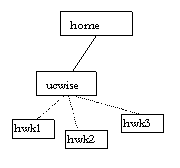One-page Introduction to Unix
Unix is an operating system, meaning you can use it to organize files and directories and to start up applications, such as a browser or a text editor.

In unix, like many other operating systems, directories can store files and other directories. In this way, you can make a “tree” shape out of directories. The top-most directory is your home directory; you will already have one existing subdirectory named “ucwise”. You will need to create more subdirectories, within “ucwise”, to contain homework files, and so forth.
Directory commands:
|
mkdir arg |
Make a new subdirectory (folder) named arg |
|
|
rmdir arg |
Remove the directory named arg. (Directory must be empty) |
|
|
cd arg |
Move to the directory named arg, which should be a subdirectory of the current directory. |
|
|
|
cd .. |
Move to the directory containing the current one (i.e., move “up” a directory) |
|
|
cd ~ |
Move to your home directory |
|
ls |
Show a listing of the contents of the current directory |
|
|
|
ls -l |
Get a long listing of the directory |
File commands:
|
cp old new |
Make a file, called new, which is a copy of the existing file old. |
|
|
rm arg |
Remove (delete) the file named arg. |
|
|
|
rm * |
Remove all the files in the current directory |
|
mv old new |
Change the name of the file from old to new. |
|
Applications (using programs):
|
stk |
Start up the scheme programming environment STk. |
|
|
mozilla& |
Startup the Mozilla browser (the “&” means that you will be able to use you unix window even while Mozilla is running). |
|
|
emacs& |
Start up the emacs editor |
|
|
|
emacs arg |
Use emacs to edit the file named arg |
|
submit arg |
Submit the assignment named arg. The submit program will try to find the proper files in the current directory. |
|
For further information, see http://www.csua.berkeley.edu/~twohey/using_unix.html